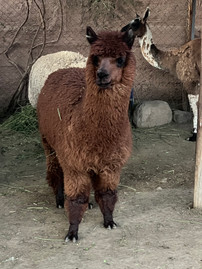Arequipa is Peru's second largest city and a major cultural, economic, and political center. It is known as the Lion of the South (el Leon del Sur) because of its streak of independence during the history of Peru and rival to the political capital of Lima. It is also known as the White City (la Ciudad Blanca) because much of the city is built from a white or pink volcanic stone called sillar. Sillar is a type of rhyolite tuff from nearby volcanoes. Interestingly, while we were in Arequipa, our nephew's partner, Jen, was defending her PhD thesis in geology at Oregon State University. Her research was of the same type of volcanic rock from the Cascade volcanoes in Oregon. We listened to her defense presentation via Zoom while sitting in the Monastery of Santa Catalina de Sienna surrounded by the stone walls of rhyolite tuff.
The architecture of Arequipa is beautiful. Arequipa was founded in 1540. The first buildings were of adobe including the cathedral built in 1544, but destroyed in an earthquake in 1583. Numerous earthquakes off the coast of Peru (the interface between the Nazca and South American tectonic plates) have damaged or destroyed many buildings over the history of Arequipa. The cathedral was rebuilt numerous times. The latest reincarnation mostly dates from the rebuilding after the 1868 earthquake. It is a beautiful building stretching the length of the north side of the main plaza. An earthquake in 2001 damaged its two towers, but they have been repaired. (There was an 7.2 magnitude earthquake near Arequipa days after we left, but little damage.)
Another beautiful complex of buildings in Arequipa is the Monastery of Santa Catalina de Siena. Established in 1579, it has been home to as many as 300 nuns and servant maids over the last 440 years. In 1970, most of the complex was opened to the public for the first time with a smaller portion of the north block still home to some cloistered nuns. We toured the many rooms and hallways of the buildings learning about the life of the nuns from our excellent guide and seeing some of the art collection of the monastery.
Much of our time in Arequipa was spent wandering around the city and enjoying the food, architecture, and culture. We also visited the museum at the Catholic University of Santa Maria which has the mummy known as Juanita and items associated with the Incan practice of child sacrifice.
Such a beautiful and relaxing city.














































































































I love those colorful arches. But why did you have a bib at that restaurant? In France they give you one when you eat lobster!!